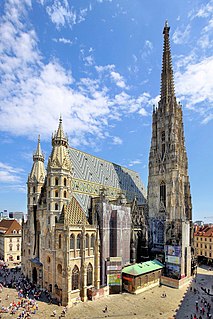
The Albertina is a museum in the Innere Stadt of Vienna, Austria. It houses one of the largest and most important print rooms in the world with approximately 65,000 drawings and approximately 1 million old master prints, as well as more modern graphic works, photographs and architectural drawings. Apart from the graphics collection the museum has recently acquired on permanent loan two significant collections of Impressionist and early 20th-century art, some of which will be on permanent display. The museum also houses temporary exhibitions.

The Hotel Imperial, also known as The Imperial, is a five-star luxury hotel in Vienna, Austria. It is located on the Ringstraße at Kärntner Ring 16.

The Palais Toskana was a palace in Vienna.1

Schloß Pötzleinsdorf or Schloss Pötzleinsdorf is a former palace in Pötzleinsdorf, Vienna.
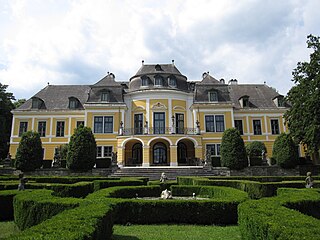
Schloss Neuwaldegg is a Baroque palace with an English garden in the Hernals borough of Vienna, Austria.1 It is currently privately owned and rented out for a variety of private and public events.

Palais Augarten is a Baroque palace in the district of Leopoldstadt, Vienna, Austria. Constructed in the late seventeenth century by Johann Bernhard Fischer von Erlach on the site of a hunting château and gardens, the palace and gardens were expanded in the nineteenth century under Emperor Franz Joseph I of Austria. Despite extensive damage suffered during World War II, the palace has been maintained almost in its original appearance, and many of the original furnishings can still be found there. Today, Palais Augarten is the home and rehearsal space of the Vienna Boys' Choir, who also have their own school there. The palace is located in the 130-acre Augarten park, which is the oldest Baroque garden in Vienna.

Palais Lobkowitz, or Palais Dietrichstein-Lobkowitz, is a Baroque palace in Vienna, Austria. It was owned by the noble Lobkowitz family.
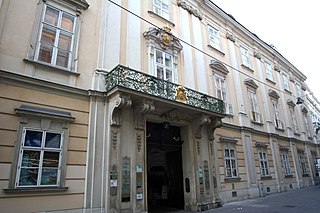
Palais Esterházy is a baroque palace in Vienna, Austria, owned by the noble Esterházy family. It houses a famous and popular restaurant in the former wine cellars, called Esterházykeller.

Palais Schönborn-Batthyány is a Baroque palace in the Innere Stadt district of Vienna, Austria.

Palais Harrach is a Baroque palace in Vienna, Austria. It was owned by the noble Harrach family. The building was extensively renovated and restored in the late 1990s, and it houses offices and shops today.
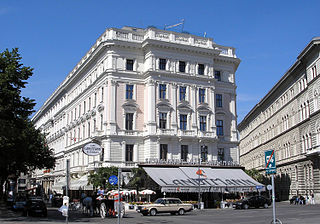
Palais Lieben-Auspitz is a Ringstraßenpalais in Vienna, Vienna, located in the city's Innere Stadt.

The Prince-Bishopric of Strassburg was an ecclesiastical principality of the Holy Roman Empire from the 13th century until 1803. During the late 17th century, most of its territory was annexed by France; this consisted of the areas on the left bank of the Rhine, around the towns of Saverne, Molsheim, Benfeld, Dachstein, Dambach, Dossenheim-Kochersberg, Erstein, Kästenbolz, Rhinau, and the Mundat. The annexations were recognized by the Holy Roman Empire in the Treaty of Ryswick of 1697. Only the part of the state that was to the right of the Rhine remained; it consisted of areas around the towns of Oberkirch, Ettenheim, and Oppenau. The remaining territory was secularized to Baden in 1803.

Barca is a village and municipality in the Rimavská Sobota District of the Banská Bystrica Region of southern Slovakia.

The Max Reinhardt Seminar is the School of Drama at the University of Music and Performing Arts in Vienna, Austria. It is located in the Palais Cumberland, Penzingerstraße 9, in Vienna's 14th district

The Roman Catholic Archdiocese of Vienna is an archdiocese of the Catholic Church in Austria. It was erected as the Diocese of Vienna on 18 January 1469 out of the Diocese of Passau, and elevated to an archdiocese on 1 June 1722. The episcopal see resides in the cathedral of Stephansdom in Vienna. The current bishop is Christoph Schoenborn, appointed in 1995 and elevated to cardinal in 1998.

Stadtpalais Liechtenstein, is a residential building at Bankgasse 9, in the first district of Vienna, Innere Stadt, and is one of two palaces in Vienna belonging to the princely family of Liechtenstein. The palace was built from 1692 to 1705 by the Italian architect Domenico Martinelli and the Swiss architect Gabriele Gabrieli.

Neugebäude Palace is a large Mannerist castle complex in the Simmering dictrict of Vienna, Austria. It was built from 1569 onwards at the behest of the Habsburg emperor Maximilian II on the alleged site of Sultan Suleiman's tent city during the 1529 Siege of Vienna and apparently modeled after it.

The Palmenhaus Schönbrunn is a large greenhouse in Vienna, Austria featuring plants from around the world. It opened in 1882. It is the most prominent of the four greenhouses in Schönbrunn Palace Park, and is also among the largest botanical exhibits of its kind in the world, with around 4,500 plant species.
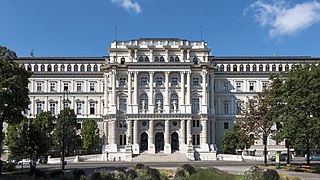
The Palace of Justice is the seat of the Supreme Court of Austria. The Neo-Renaissance building erected from 1875 to 1881 is located in the Austrian capital Vienna on Schmerlingplatz, a square near the Ringstraße boulevard in the central district of Innere Stadt. In addition to the Supreme Court, the Palace of Justice houses the Higher Regional Court of Vienna and the Regional Court for Civil Matters Vienna and the General Prosecution and the Supreme Public Prosecutor for Vienna.

The Musée d'art moderne de Troyes is one of the two main museums in the French city of Troyes - the other is the Musée des Beaux-Arts de Troyes. It is located in the city's former 16th- and 17th-century episcopal palace. It was opened in 1982 by president François Mitterrand following Pierre and Denise Lévy's 1976 donation of several modern artworks to their home-town of Troyes.


